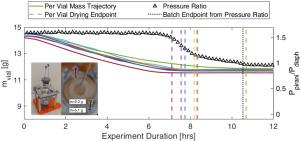真空兼容弹簧线系统,用于小瓶在冻干过程中的质量测量
IF 3.7
2区 工程技术
Q2 ENGINEERING, MANUFACTURING
Precision Engineering-Journal of the International Societies for Precision Engineering and Nanotechnology
Pub Date : 2025-07-25
DOI:10.1016/j.precisioneng.2025.07.007
引用次数: 0
摘要
药物冻干(真空冷冻干燥)通过去除99.9%的水分来稳定含水制剂,通常在小瓶中。未能去除足够的水分会导致产品不稳定,因此测量整个过程中去除的水量至关重要。目前的技术可以测量一批小瓶的总水去除率或破坏性地测量样品小瓶的最终水含量,但它们不能在原位监测单个小瓶。对每个小瓶的含水量进行在线测量将评估干燥过程中的变化,从而实现工艺改进和小瓶特定优化。这项工作提出了一种质量传感器,在整个冻干过程中实现这种单个小瓶测量。这种质量传感器由两个部分螺旋弹簧组成,其中包含悬浮的小瓶。当水在干燥过程中从瓶中升华时,螺旋弹簧的自由末端的位置和方向发生变化。这种变化被传感臂放大,并由真空室外的照相机测量。传感臂末端的光学基准使放大运动的高保真测量成为可能。该传感器提供单个小瓶质量信息,允许跟踪其升华速率,而不影响冻干过程。通过为10R小瓶建立10个传感器来评估传感器设计,填充量为3ml。校准后,这些传感器的离线测试误差中值为13 mg,当使用最大后验方法更新校准系数时,误差中值提高到6.5 mg。当传感器在冻干环境中进行测试时,其最终测量质量的中位数误差增加到50mg,这可能是由于传感器组件之间接触区域的微滑移导致的滞后。然而,每个小瓶升华率被精确测量,并用于推断干燥终点。本文章由计算机程序翻译,如有差异,请以英文原文为准。

Vacuum compatible spring wire system for mass measurement of vials during lyophilization
Pharmaceutical lyophilization (vacuum freeze-drying) stabilizes aqueous formulations, commonly in vials, by removing 99.9% of their water. Failure to remove enough water leads to unstable products, so measuring the amount of water removed throughout the process is critical. Current technologies can measure the total rate of water removal from a batch of vials or destructively measure the final water content of sample vials, but they cannot monitor individual vials in situ. An in-line measurement for the water content of every vial would assess variation in the drying process, enabling process improvements and vial-specific optimizations. This work presents a mass sensor that achieves this individual vial measurement throughout the lyophilization process.
This mass sensor consists of two partial helical springs holding a suspended vial. As water sublimates from the vial during drying, the position and orientation of the free ends of the helical springs change. This change is amplified by sensing arms and measured by a camera outside of the vacuum chamber. Optical fiducials at the ends of the sensing arms enable high-fidelity measurement of the amplified motion. This sensor provides individual vial mass information, allowing tracking of its sublimation rate, without affecting the lyophilization process.
The sensor design was evaluated by building ten sensors for 10R vials with a 3 mL fill. After calibration, these sensors achieved a median offline testing error of 13 mg, which improved to 6.5 mg when calibration coefficients were updated using the maximum a posteriori method. When the sensors were tested in a lyophilization environment, the median error in their final mass measured increased to 50 mg, likely due to micro-slip of the sensor assembly contact regions between measurements introduced hysteresis. Nevertheless, per vial sublimation rates are measured accurately and used to infer drying endpoints.
求助全文
通过发布文献求助,成功后即可免费获取论文全文。
去求助
来源期刊
CiteScore
7.40
自引率
5.60%
发文量
177
审稿时长
46 days
期刊介绍:
Precision Engineering - Journal of the International Societies for Precision Engineering and Nanotechnology is devoted to the multidisciplinary study and practice of high accuracy engineering, metrology, and manufacturing. The journal takes an integrated approach to all subjects related to research, design, manufacture, performance validation, and application of high precision machines, instruments, and components, including fundamental and applied research and development in manufacturing processes, fabrication technology, and advanced measurement science. The scope includes precision-engineered systems and supporting metrology over the full range of length scales, from atom-based nanotechnology and advanced lithographic technology to large-scale systems, including optical and radio telescopes and macrometrology.

 求助内容:
求助内容: 应助结果提醒方式:
应助结果提醒方式:


